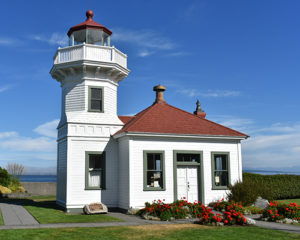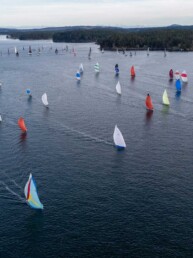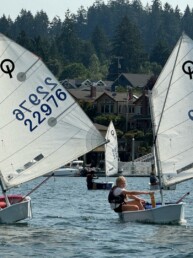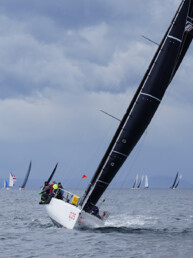This article was originally published in the October 2021 issue of 48° North.
What is it about lighthouses that makes them so alluring? Although they were designed to keep vessels and mariners at a distance from shore, today they attract crowds of visitors. Lighthouses in the Salish Sea remind us that our region has been connected by water for centuries, particularly when overland travel was difficult. To mariners navigating darkness and fog, they were beacons of safe passage. Yet their legacy is complicated. Placed along the shoreline of shipping lanes, they facilitated commerce and development while also symbolizing colonization and settlement.
Lighthouses are among the most visible remnants of our region’s maritime heritage — structures that combine rugged, isolated landscapes and human ingenuity, providing a glimpse into how nature and culture intertwine in the Salish Sea. The tower at Mukilteo is a remarkable example, and one that is accessible to boaters.
Building the Light Station
 The Mukilteo Light Station is located on the east side of Possession Sound at Point Elliott. Native peoples called this place Muckl-te-oh, meaning “good camping ground” or “narrow passage,” and the site was a gathering and trading center. It was here that 82 tribal leaders signed a treaty ceding their territories in 1855. In the early 20th century, the U.S. Lighthouse Board, a federal agency under the Department of Treasury, concluded that a signal should be placed at Mukilteo to guide the increasing vessel traffic through Possession Sound. Completed in 1906, the station included a lighthouse and fog signal building, houses for the station keeper and assistant keeper and their families, an oil house, and a windmill built over a well.
The Mukilteo Light Station is located on the east side of Possession Sound at Point Elliott. Native peoples called this place Muckl-te-oh, meaning “good camping ground” or “narrow passage,” and the site was a gathering and trading center. It was here that 82 tribal leaders signed a treaty ceding their territories in 1855. In the early 20th century, the U.S. Lighthouse Board, a federal agency under the Department of Treasury, concluded that a signal should be placed at Mukilteo to guide the increasing vessel traffic through Possession Sound. Completed in 1906, the station included a lighthouse and fog signal building, houses for the station keeper and assistant keeper and their families, an oil house, and a windmill built over a well.
Local newspapers kept tabs on the progress of construction. The Seattle Post-Intelligencer informed its readers on February 9, 1906, that the new fog horn “was heard along the waterfront for the first time this morning,” attracting inquisitive bystanders. A few weeks later The Seattle Daily Times proudly declared that “the light is considered without exception the most up-to-date and thoroughly equipped station on the Sound.” The Everett Morning Tribune summarized the sense of excitement. “The government lighthouse at Mukilteo flashed its guiding rays for the first time over the dark waters of Puget Sound last night,” announced an article in March of 1906. “Dozens of people curiously watched the glimmer of the lamp as it shot its beams of yellow light…”
The Victorian-style lighthouse featured several noteworthy elements. Designed by architect Carl W. Leick, it was constructed of wood at a time when many lighthouses were made of brick and concrete. The tower had an octagonal shape with delicate brackets and the houses included embellished entryways, steep-pitched roofs with ornate gables, and windows marked with decorative flourishes. In spite of these nuances, the light station was sturdy and functional, demonstrating Leick’s promise to “build ’em stout, and make ’em last.”
The tower displayed a revolving Fresnel lens, manufactured in France, which required a flame for illumination. Rotating every five seconds, it was visible from 10 miles away. To Joanne Mulloy, current president of the Mukilteo Historical Society, the lens remains “a work of art,” revealing how light passing through prisms can be projected across the water for precise distances. The fog signal was a marvel as well. It used compressed air passing across a vibrating reed, which was blasted into Possession Sound by a large trumpet-style horn extending through the wall.
The Light Keepers
Much of the appeal of lighthouses comes from the mystique associated with the keepers — hardy souls who braved extreme and isolated conditions. Mukilteo’s lighthouse, unlike many in the early 20th century, was located near a school and supply stores, which may have increased its desirability for Peter Christiansen, the first keeper. A Norwegian immigrant and employee of the Lighthouse Service, Christiansen was a former Navy man with a tattoo on his arm that read “sailor with girl.” He received the post at Mukilteo in part as a reward for serving as assistant keeper at the Turn Point Lighthouse on Stuart Island in the San Juan Islands, where he helped save the drunken crew of the tugboat Enterprise when they ran aground in 1897 during a winter storm. In 1906, Christiansen moved his wife, Theodine, and several children into the spacious house at the Mukilteo Light Station; while the assistant light keeper, David O. Kinyon, lived in the second house.
For all the advantages of the assignment, the work at the Mukilteo Light Station was relentless. Every evening before sunset, the keeper climbed the tower stairs to light the lamp inside the Fresnel lens, repeating the task every three or four hours during the night. The mechanism that rotated the lens required adjusting to produce the flashing pattern. The wick had to be trimmed and the lens and tower windows had to be cleaned. The keeper also monitored the fog horn’s compression machinery, while maintaining the light station’s windmill and water pump as well as the grounds. According to Peter Anderson of the Mukilteo Historical Society, everyone living at the light station pitched in. When Christiansen died in 1925, Theodine served as light keeper until she was replaced by Edward Brooks a few years later. The lighthouse and fog signal were automated in 1979, and two years later a remote fog sensor was installed, marking the end of an era.
The Mukilteo Light Station was part of a system of navigational aids throughout Puget Sound that helped pave the way for commerce and development. In 1919, a car ferry at this location began carrying vehicles and passengers to Whidbey Island, joining a fleet of vessels expanding marine transportation options throughout the region.
Visiting the Mukilteo Light Station
Today, the City of Mukilteo maintains the station buildings and structures, in partnership with volunteers at the Mukilteo Historical Society. The site, which is open to the public and available for private tours, continues to demonstrate that our communities have been deeply connected by water for centuries. Canoes still gatherhere during annual Tribal Journeys.
The light station buildings remain mostly intact and are listed in the Washington Heritage Register and National Register of Historic Places, owing to their significance in marine technology, architecture, and association with the region’s development. And, of course, modern mariners still depend on its reliable light and fog signals to complement even the most cutting-edge navigational equipment.
The light station features the only active Fresnel lens in Washington — and the U.S. Coast Guard can activate its fog horn. The signature sound is a three-second blast every 27 seconds.
For more information, see:
mukilteowa.gov/departments/recreation/parks-open-spaces-trails/lighthouse-park/
Lisa Mighetto is a historian living in Seattle. Her articles have appeared in Cruising World, Sailing Magazine, Pacific Yachting, and other publications.






